DON'T SWEAT THE TEST! Having a problem with math? Nervous about your test? This book introduces all the topics you need to know about geometry. Learn great test-taking tips for solving multiple choice, short-answer, and show-your-work questions. A great book for students to use on their own, or with parents, teachers, or tutors.
"This book is an excellent tool for a student to review basic geometry skills or master new concepts."
Patricia Leonard, MS, Series Math Consultant,
Middle School Math Professional
Need More Practice?
FREE WORKSHEETS AVAILABLE AT ENSLOW.COM
About The Author
AUTHOR REBECCA WINGARD-NELSON has worked in public, private, and home-school mathematics education. She has been involved in various educational math projects, including developing and writing state assessment tests, exit exams, and proficiency tests, as well as writing and editing textbooks and workbooks.

Most of the topics that are found on math tests are taught in the classroom. Paying attention in class, taking good notes, and keeping up with your homework are the best ways to be prepared for tests.
Use test preparation materials, such as flash cards and timed worksheets, to practice your basic math skills. Take practice tests. They show the kinds of items that will be on the actual test. They can show you what areas you understand, and what areas you need more practice in. Relax. Eat a good meal.
Go to bed early enough to get a good nights sleep. Dont cram on new material! Review the material you know is going to be on the test. Get what you need ready. Sharpen your pencils, set out things like erasers, a calculator, and any extra materials, like books, protractors, tissues, or cough drops. Get up early enough to eat breakfast and not have to hurry. Wear something that is comfortable and makes you feel good.
Listen to your favorite music. Get to school and class on time. Stay calm. Stay positive. Before you begin, take a deep breath. Focus on the test, not the people or things around you.
Remind yourself to do your best and not worry about what you do not know. Work through the entire test, but dont spend too much time on any one problem. Dont rush, but move quickly, answering all of the questions you can do easily. Go back a second time and answer the questions that take more time. Read each question completely. Read all the answer choices.
Eliminate answers that are obviously wrong. Read word problems carefully, and decide what the problem is asking. Check each answer to make sure it is reasonable. Estimate numbers to see if your answer makes sense. Concentrate on the test. Stay focused.
If your attention starts to wander, take a short break. Breathe. Relax. Refocus. Dont get upset if you cant answer a question. Mark it, then come back to it later.
When you finish, look back over the entire test. Are all of the questions answered? Check as many problems as you can. Look at your calculations and make sure you have the same answer on the blank as you do on your worksheet. Three common types of test problems are covered in this book: Multiple Choice, Show Your Work, and Explain Your Answer. Tips on how to solve each, as well as common errors to avoid, are also presented.
A point is an exact location.A point is an exact location.
Points have no length or width. A point may be thought of as a dot on a piece of paper.What point is shown in red? Step 1: Find the red point. The capital letter next to the point, B, names the point. In geometry, points are normally named by a capital letter. Point B is shown in red. A line is a straight set of points that travel in two directions without end.
Step 1: Find the red point. The capital letter next to the point, B, names the point. In geometry, points are normally named by a capital letter. Point B is shown in red. A line is a straight set of points that travel in two directions without end.
Lines can be thought of as the straight lines that can be drawn with a ruler on a piece of paper. Arrows are used to show that the line extends in both directions forever.
 Which of the following is NOT a way to name the line shown?
Which of the following is NOT a way to name the line shown?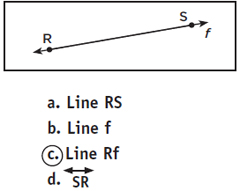
Lines can be named by any two points on the line. Answer a uses the word
line and two points. Answer d uses the symbol for line and two points. Both of these are correct. A line can also be named using a lowercase letter.
Answer b uses the lowercase letter f. Answer c is not a correct way to name a line. Solution: The correct answer is c.
Multiple choice questions give you a set of answers. You choose which of the given answers is correct.line segment: Part of a line with two endpoints.ray: Part of a line that starts at one endpoint and extends without end in one direction.plane: A flat surface that extends in all directions without end.Name three line segments that have point B as one endpoint. Step 1:
Step 1: Line segments are named using two endpoints in any order. The symbol for a line segment is similar to that for a line, but it has no arrow.
The segment that has endpoints at point A and B can be named  or
or  . Choose any three segments that have point B as an endpoint.
. Choose any three segments that have point B as an endpoint. 
 Draw a figure that includes line LX and ray XY.
Draw a figure that includes line LX and ray XY. Each person who draws this figure may have a different looking answer. Some problems can have different answers and still be correct. In this problem, line LX and ray XY share point X. Draw line LX to begin.
A ray is named using the endpoint first and then any other point on the ray. Ray XY, or  has an endpoint at point X, then extends forever in a direction that goes through point Y. Draw a point Y, and extend a ray through it.
has an endpoint at point X, then extends forever in a direction that goes through point Y. Draw a point Y, and extend a ray through it. 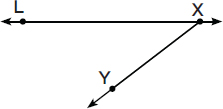
Questions that do not give you solutions to choose from are sometimes called Show Your Work questions. You may need to fill in a blank, make a drawing or graph, or show the equations or work that you used to find your answer.intersecting lines: Lines that meet or cross.point of intersection: The place where two lines or line segments meet.Lines AB and CD are intersecting lines. The point of intersection is point S.


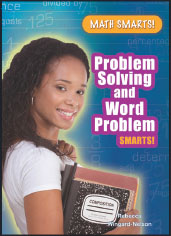


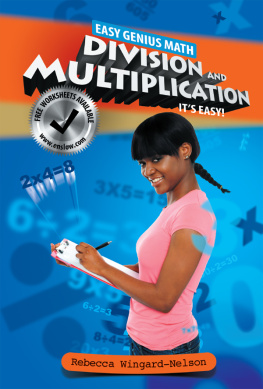
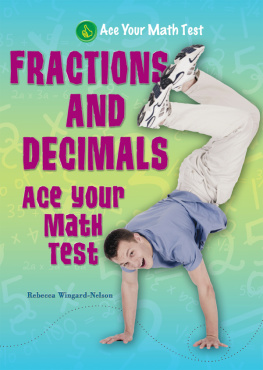
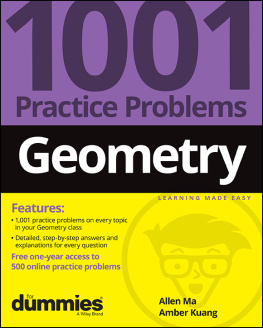






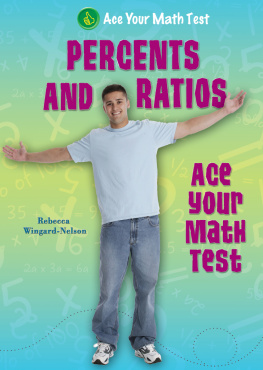

 Most of the topics that are found on math tests are taught in the classroom. Paying attention in class, taking good notes, and keeping up with your homework are the best ways to be prepared for tests.
Most of the topics that are found on math tests are taught in the classroom. Paying attention in class, taking good notes, and keeping up with your homework are the best ways to be prepared for tests.  Step 1: Find the red point. The capital letter next to the point, B, names the point. In geometry, points are normally named by a capital letter. Point B is shown in red. A line is a straight set of points that travel in two directions without end.
Step 1: Find the red point. The capital letter next to the point, B, names the point. In geometry, points are normally named by a capital letter. Point B is shown in red. A line is a straight set of points that travel in two directions without end.
 Which of the following is NOT a way to name the line shown?
Which of the following is NOT a way to name the line shown? Lines can be named by any two points on the line. Answer a uses the word line and two points. Answer d uses the symbol for line and two points. Both of these are correct. A line can also be named using a lowercase letter.
Lines can be named by any two points on the line. Answer a uses the word line and two points. Answer d uses the symbol for line and two points. Both of these are correct. A line can also be named using a lowercase letter.  Step 1: Line segments are named using two endpoints in any order. The symbol for a line segment is similar to that for a line, but it has no arrow.
Step 1: Line segments are named using two endpoints in any order. The symbol for a line segment is similar to that for a line, but it has no arrow.  or
or  . Choose any three segments that have point B as an endpoint.
. Choose any three segments that have point B as an endpoint. 
 Draw a figure that includes line LX and ray XY. Each person who draws this figure may have a different looking answer. Some problems can have different answers and still be correct. In this problem, line LX and ray XY share point X. Draw line LX to begin.
Draw a figure that includes line LX and ray XY. Each person who draws this figure may have a different looking answer. Some problems can have different answers and still be correct. In this problem, line LX and ray XY share point X. Draw line LX to begin.  has an endpoint at point X, then extends forever in a direction that goes through point Y. Draw a point Y, and extend a ray through it.
has an endpoint at point X, then extends forever in a direction that goes through point Y. Draw a point Y, and extend a ray through it. 
